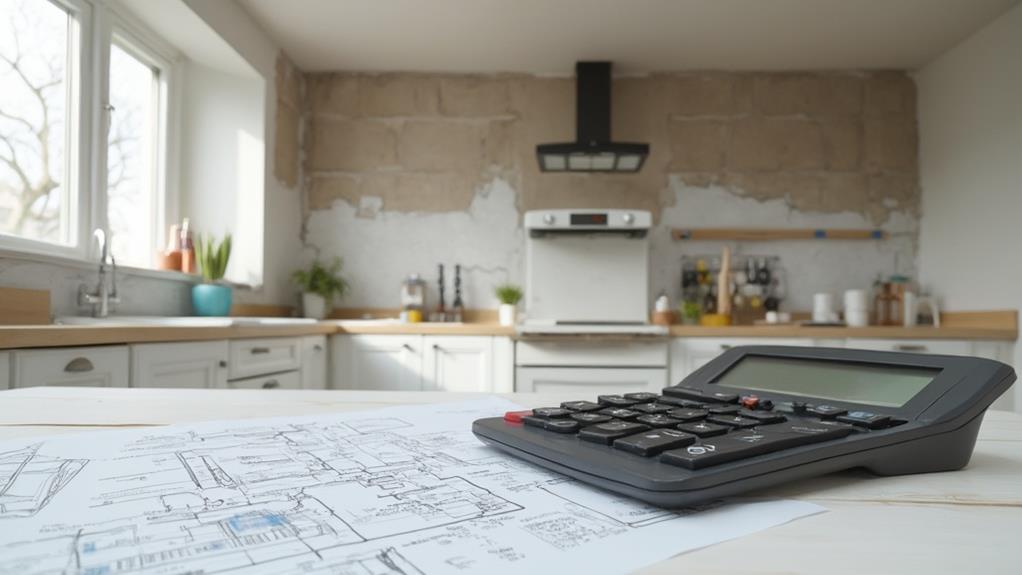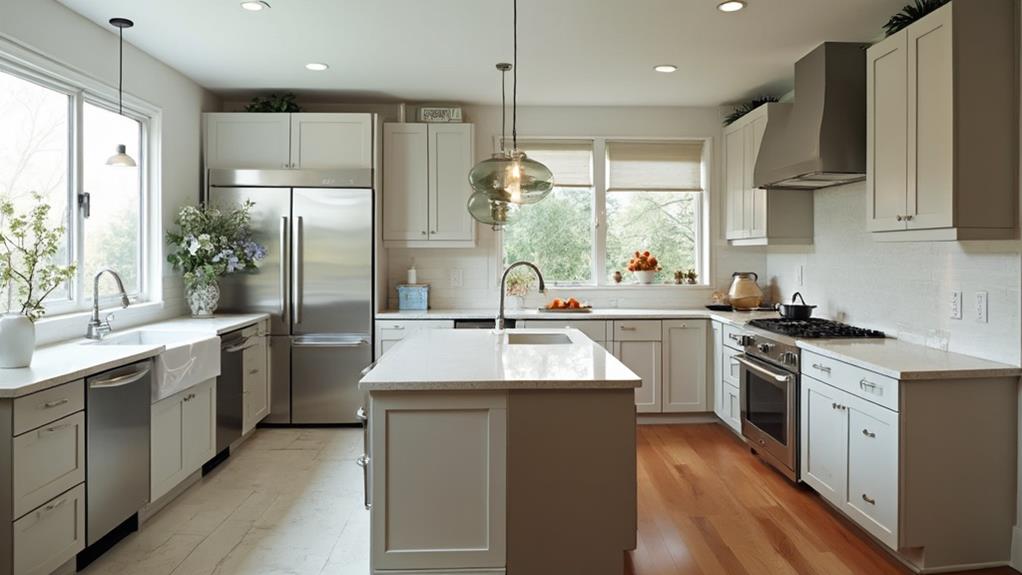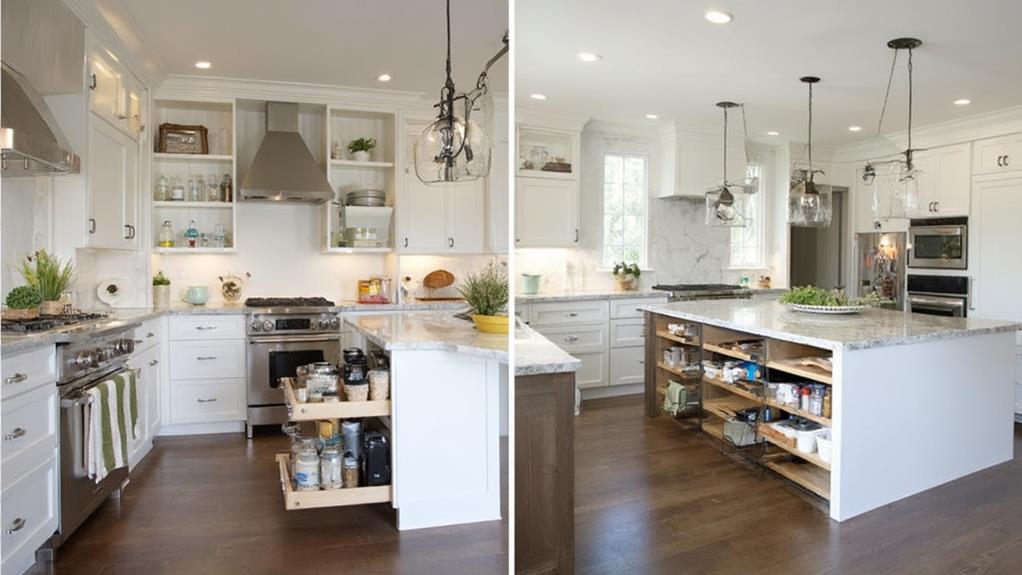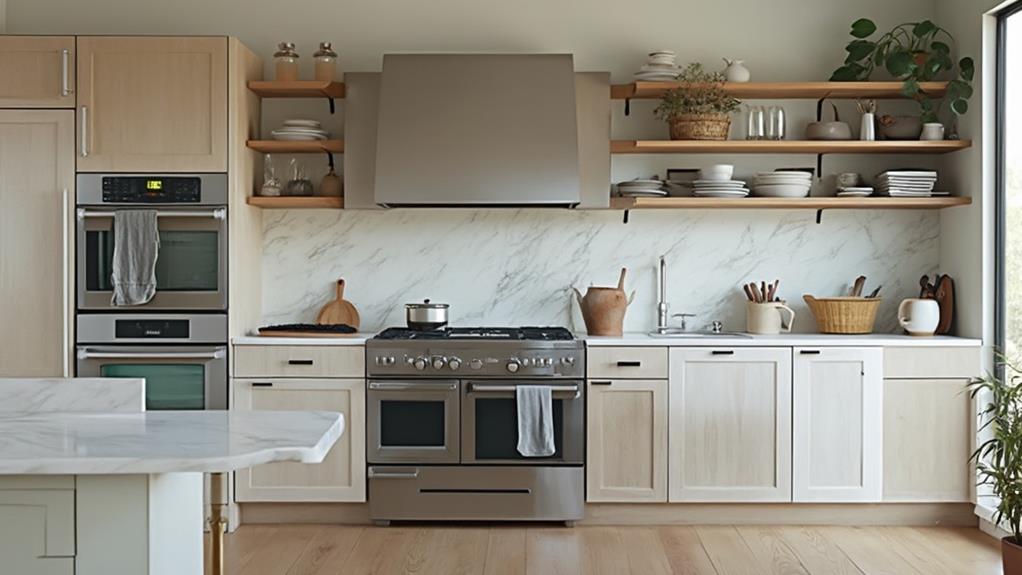When remodeling your kitchen, do establish a realistic budget with a 10-20% contingency for unexpected expenses. Don't overlook the importance of layout and functionality, ensuring an efficient work triangle and adequate counter space. Do invest in high-quality, durable materials for countertops, cabinetry, and appliances. Don't skimp on lighting; incorporate a mix of task, ambient, and accent lighting. Do maximize storage with pull-out shelves, vertical spaces, and organizational solutions. Don't tackle complex jobs like electrical work or plumbing yourself; leave these to professionals. By following these dos and don'ts, you'll be well on your way to creating your dream kitchen. But there's more to consider for a truly successful renovation.
Budget Planning and Management

Planning your budget is the cornerstone of any successful kitchen remodel. It's crucial to establish a realistic budget before diving into the project. Start by researching average costs for kitchen renovations in your area and determine how much you're willing to spend. Don't forget to set aside 10-20% of your budget for unexpected expenses.
Do create a detailed breakdown of costs for materials, labor, and appliances. This will help you prioritize where to allocate your funds and identify areas where you can save. Don't underestimate the importance of quality materials and workmanship, as cutting corners can lead to costly repairs down the line.
Be flexible with your budget, but don't let it spiral out of control. Keep track of expenses throughout the project and make adjustments as needed. If you're working with a contractor, ensure they provide itemized quotes and stick to the agreed-upon budget.
Consider financing options if necessary, but don't overextend yourself financially. Remember, a well-planned budget will help you achieve your dream kitchen without breaking the bank or compromising on quality.
Layout and Functionality Considerations
With your budget in place, it's time to focus on your kitchen's layout and functionality. Consider the classic work triangle, connecting your sink, stove, and refrigerator. This layout minimizes unnecessary steps and maximizes efficiency. Don't forget to plan for adequate counter space, especially near major appliances and prep areas.
Think about your specific needs and habits. If you're an avid baker, allocate space for a separate baking station. For frequent entertainers, consider an island with seating or a open-concept design. Ensure there's enough storage for your cookware, utensils, and small appliances.
Pay attention to traffic flow. You don't want your kitchen to become a bottleneck during busy times. Plan for at least 36 inches of walkway space.
Lighting is crucial for both functionality and ambiance. Incorporate a mix of task, ambient, and accent lighting. Under-cabinet lights can significantly improve workspace visibility.
Don't neglect ventilation. A powerful range hood will keep your kitchen fresh and smoke-free. Lastly, consider the placement of electrical outlets. You'll need them for small appliances and charging devices. Strategically place them to avoid cluttering your backsplash or countertops.
Material Selection and Quality

Quality is paramount when selecting materials for your kitchen remodel. Choose durable, long-lasting materials that can withstand daily wear and tear. Opt for high-grade countertops like quartz or granite, which resist scratches and stains.
For flooring, consider hardwood, porcelain tile, or luxury vinyl plank for their durability and easy maintenance.
Don't skimp on cabinetry. Invest in solid wood or high-quality plywood constructions with sturdy hardware. Avoid particle board or MDF, as they're less durable and prone to water damage.
When it comes to appliances, select energy-efficient models from reputable brands to ensure longevity and performance.
For backsplashes, use materials that are easy to clean and maintain, such as ceramic or glass tiles. Stainless steel sinks are a popular choice for their durability and resistance to stains and scratches.
When choosing faucets and fixtures, look for those with ceramic disc valves and high-quality finishes to prevent leaks and corrosion.
Lighting and Electrical Updates
Illuminating your kitchen properly can transform both its functionality and ambiance. When planning your lighting updates, consider a layered approach with task, ambient, and accent lighting.
Install under-cabinet lights to brighten work surfaces, pendant lights over islands or dining areas, and recessed lights for overall illumination. Don't forget to include dimmer switches for versatility.
As for electrical updates, ensure your kitchen can handle modern appliances and gadgets. Add plenty of outlets, including GFCI-protected ones near water sources. Consider installing USB ports for charging devices. If your home is older, you may need to upgrade your electrical panel to accommodate increased power demands.
When it comes to fixture selection, choose energy-efficient LED options that complement your kitchen's style. Avoid overly trendy designs that may look dated quickly. Don't skimp on professional installation, especially for complex electrical work. It's crucial for safety and code compliance.
Lastly, think about smart home integration. Wi-Fi-enabled lights and appliances can add convenience and energy savings. However, don't go overboard with technology if you're not comfortable using it. Balance functionality with your personal preferences and lifestyle needs.
Storage and Organization Solutions

An organized kitchen is a joy to work in, and smart storage solutions can make all the difference. When remodeling, prioritize efficient storage to maximize your space. Do install pull-out shelves in lower cabinets for easy access to pots, pans, and small appliances. Don't overlook vertical space; use tall cabinets or pantries to store less frequently used items.
Do incorporate a variety of storage options, such as deep drawers for dishes, utensil dividers, and spice racks. Consider adding a kitchen island with built-in storage for additional workspace and organization. Don't forget about corner cabinets; lazy Susans or pull-out systems can make these often-wasted spaces more functional.
Do plan for specific storage needs, like a designated area for cutting boards or a built-in knife block. Don't clutter your countertops; instead, use wall-mounted rails or under-cabinet storage for frequently used items. Do think about future needs and leave room for growth. Consider adjustable shelving systems that can adapt as your storage requirements change. Don't neglect the importance of good lighting in storage areas; it'll help you find what you need quickly and easily.
Professional Help vs. DIY
The decision to hire professionals or tackle a kitchen remodel yourself is a crucial one. Consider your skills, budget, and available time before making this choice.
If you're handy and have experience with home improvement projects, you might be able to handle some aspects of the remodel. Simple tasks like painting, installing backsplashes, or updating hardware can often be DIY-friendly.
However, complex jobs like electrical work, plumbing, or structural changes should be left to professionals. They've the expertise and tools to ensure the work is done safely and up to code. Professional help also saves time and can prevent costly mistakes.
If you decide to go the DIY route, be realistic about your abilities and the project's scope. Research thoroughly, gather the necessary tools, and don't hesitate to consult experts when needed.
For a hybrid approach, consider hiring professionals for specialized tasks while tackling simpler jobs yourself.
Conclusion
As you embark on your kitchen remodeling journey, remember that it's a recipe for success when you blend careful planning with inspired design. Don't let budget constraints chop your dreams; instead, slice them into manageable pieces. Whisk together functionality and aesthetics, and sprinkle in professional help where needed. With these ingredients in your toolkit, you'll cook up a kitchen that's not just a feast for the eyes but a joy to use every day.

